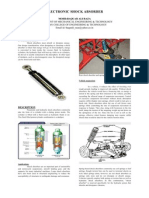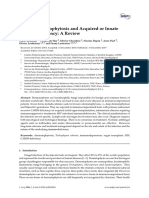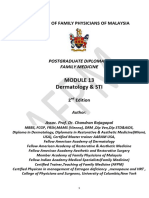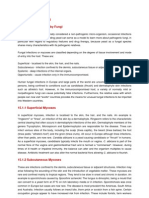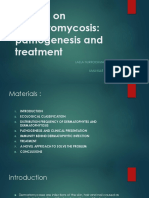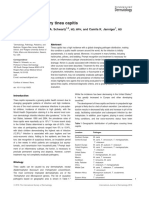Tinea Corporis, Caused by Microsporum Canis - A Case Report From Kosovo
Tinea Corporis, Caused by Microsporum Canis - A Case Report From Kosovo
Uploaded by
Asterlita RyaneCopyright:
Available Formats
Tinea Corporis, Caused by Microsporum Canis - A Case Report From Kosovo
Tinea Corporis, Caused by Microsporum Canis - A Case Report From Kosovo
Uploaded by
Asterlita RyaneOriginal Description:
Original Title
Copyright
Available Formats
Share this document
Did you find this document useful?
Is this content inappropriate?
Copyright:
Available Formats
Tinea Corporis, Caused by Microsporum Canis - A Case Report From Kosovo
Tinea Corporis, Caused by Microsporum Canis - A Case Report From Kosovo
Uploaded by
Asterlita RyaneCopyright:
Available Formats
Published online:04/10/2015 Published print:10/2015
CASE REPORT Tinea Corporis, Caused by
doi: 10.5455/medarh.2015.69.345-346
Med Arh. 2015 Oct; 69(5): 345-346
Received: September 05th 2015 | Accepted: October
Microsporum Canis - a Case
Report From Kosovo
05th 2015
© 2015 Fatime Kokollari, Aferdita Daka,
Ymrane Blyta, Fellanza Ismajli, Kujtesa
Haxhijaha-Lulaj Fatime Kokollari1,2, Aferdita Daka1,2, Ymrane Blyta1,2, Fellanza
Ismajli1, Kujtesa Haxhijaha-Lulaj1
This is an Open Access article distributed
under the terms of the Creative Commons 1
Department of Dermatovenerology, University Clinical Centre of Kosovo, Prishtina,
Attribution Non-Commercial License Kosovo
(http://creativecommons.org/licenses/ 2
Medical School, University of Prishtina, Prishtina, Kosovo
by-nc/4.0/) which permits unrestricted
Corresponding author: Fatime Kokollari, MD. Department of Dermatovenerology,
non-commercial use, distribution, and
University Clinical Centre of Kosovo. 10000 Prishtina, Kosovo. Phone: ++37744258304.
reproduction in any medium, provided
E-mail: fatime.kokollari@gmail.com
the original work is properly cited.
ABSTRACT
INTRODUCTION: Tinea corporis (B35.6) caused by Microsporum canis which is fungal spe-
cies that causes numerous forms of disease. It is part of a group of fungi known as Derma-
tophytes. Though mostly well known for ringworm in pets, it is also known to infect humans.
This fact makes this pathogen both anthrophilic and zoophilic in nature. Microsporum
canis is a communicable pathogen. Case report: We will report about a case, 22-year-
old female, residing in a village, with typical changes of a mycotic infection caused by M.
Canis. Dermatological description can be summarized with polymorphic erythematous,
papulosquamous changes, erosions mainly on genital organ and spread to the thighs and
lower abdomen which are accompanied with itching and burning. Diagnosis B35.6 was
determined on the basis of clinical appearance complemented with anamnesis, micro-
scopic examination and culture. The patient was treated successfully with general and
local antimycotics and antibiotics.
Key words: tinea groin B35.6 caused by M. Canis.
1. INTRODUCTION the lesions can appear as overlap-
Dermatophytosis (tinea) infec- ping concentric circles (tinea imbri-
tions are fungal infections caused cate) (7).
by dermatophytes - a group of fungi Reactions to a dermatophyte in-
that invade and grow in dead keratin fection may range from mild to se-
(1). Infection is limited to the dead vere as a consequence of the host’s
layers of skin but encouraged by a reactions to the metabolic products
damp and warm local environment. of the fungus, the virulence of the
The infection can be transmitted infecting strain or species, the ana-
to humans by anthropophilic (be- tomic location of the infection, and
tween people), geophilic (from soil) local environmental factors (8).
and zoophilic (from animals) spread Fungal transmission occurs
(2). Infection is very common all through direct contact with in-
over the world. Tinea cruris is three fected persons, animals, soil or fo-
times more common in men than in mites. Zoophilic sources should be
women because of the scrotal anat- identified (if possible) and treated
omy (3, 4). Itching, rash and nail to prevent human reinfection (9).
discoloration are the most common The classic presentation of tinea
symptoms of tinea infection (2). Tin- infection, known as “ringworm,” is
ea cruris, commonly referred to as a lesion with central clearing sur-
“jock itch,” involves the medial as- rounded by an advancing, red, scaly,
pect of the upper thighs (groin) (5, elevated border. One or more lesions
6). Complications such as secondary may appear. Inflammation assists in
infection (cellulitis and impetigo) colonization and may result in ves-
can lead to symptoms (2). The skin icles on the border of the affected
lesions have annular scaly plaques area. Atopic persons and those in-
with raised edges. More unusually fected with zoophilic fungi tend to
CASE REPORT | Med Arh. 2015 Oct; 69(5): 345-346 345
Familial Pompe Disease
have more inflammation. The
presentations of tinea infections
range from mild scaling and er-
ythema to severe inflammation
with bacterial superinfection.
The differential diagnosis:
Multiform erythema, annular
granuloma, nummular derma-
titis, rosea pityriasis, versicolor
pityriasis, psoriasis, Secondary
syphilis, candidal intertrigo.
We report on a case diagnosed
not directly due to delay of vis-
iting a doctor by the patient be-
cause of stigma and prejudice
Figure 1. Patient’s status before starting tretment and after beginning of tretment
attributed to local environment,
lack of experience of the family
doctor and specialist regional dermatologist in right di- ment of the disease. The differential diagnosis was: Mul-
agnosis and treatment. The case is a 22-year-old female, tiform erythema, annular granuloma, nummular der-
with mycotic infection in the genital area (Figure 1). matitis, rosea pityriasis, versicolor pityriasis, psoriasis,
Secondary syphilis, candidal intertrigo but we were also
2. CASE REPORT based on clinical appearance, anamnesis complementing
Female, 22 years old, lives in the village, hospitalized it with microscopic examination and fungal culture.
due to skin changes in the genital pubic part, thighs and
lower abdomen, which are accompanied with extraordi- 4. CONCLUSION
nary itching and burning. We consider that the report on the mentioned case
The changes had started much time before but she will be beneficial to family doctors so they can comple-
delayed her visit to the doctor to the point when her ment their professional experience with more extensive
condition deteriorated with fever and temperature. She knowledge on clinical manifestation, diagnosis and dif-
was treated unsuccessfully for two months in a row and ferential diagnosis.
the disease advanced. The changes began with rash and
itching presented in genitalia and then changes spread to CONFLICT OF INTEREST: NONE DECLARED
areas around. In anamnesis, the patient denies that other
members of the family have similar changes whereas she REFERENCES
claims to own and have in family care a dog and a cat and 1. Martinez DA, Oliver BG, Graser Y, et al. Comparative genome
no other domestic animals. She comes from a low level analysis of Trichophyton rubrum and related dermatophytes
of socio-economic status. In dermatological description, reveals candidate genes involved in infection. MBio. 2012 Sep
4; 3(5): e00259-12. doi: 10.1128/mBio.00259-12.
changes are polymorphic, plaques in the pubic area with
2. Dermatophytosis; Mycology Online, 2012 (last modified 2015)
erythematous fluorescence, pustules, erosions, crusts 3. Hainer BL; Dermatophyte infections. Am Fam Physician. 2003
and papulosquamous changes in the shape of circles in Jan 1; 67(1): 101-108.
thighs and lower abdomen which are accompanied with 4. Borman AM, Campbell CK, Fraser M, et al;.Analysis of the der-
intensive itching. The center of the circles is inactive matophyte species isolated in the British Isles between 1980 and
while the surrounding is active with distinctive border- 2005 and review of worldwide dermatophyte trends over the last
ing line to the skin around. Due to scratching because three decades. Med Mycol. 2007 Mar; 45(2): 131-141.
of itching, there was a secondary overlapping bacterio- 5. Lachapelle JM, DeDoncker P, Tennestedt D, Cauwenbergh G,
logical layer. Diagnosis was determined on the basis of Janssen PA. Itraconazole compared with griseofulvin in the
treatment of tinea corporis/cruris and tinea pedis/manus: an in-
clinical appearance, anamnesis, positive dermatophytes
terpretation of the clinical results of all completed double-blind
microscopic view and culture M. Canis. The patient was studies with respect to the pharmacokinetic profile. Dermatol-
treated with general and local antimycotics (terbinaphin ogy. 1992; 184: 45-50.
250 mg/day for 4 weeks), as well as with antibiotics ac- 6. Voravutinon V. Oral treatment of tinea corporis and tinea cru-
cording to sensitivity chart. ris with terbinafine and griseofulvin: a randomized double blind
comparative study. J Med Assoc Thai. 1993; 76: 388-393.
3. DISCUSSION 7. Fungal skin infection–body and groin; NICE CKS, Septem-
From the anamnesis of the reported case is empha- ber 2014.
sized the continuous itching which never stopped for the 8. Irene Weitzman And Richard C. Summerbell; The Dermato-
phytes; Clinical Microbiology Reviews,. 1995; 8(2): 240–259..
whole time being described as terrible and which corre-
9. Hay R. Dermatophytosis and other superficial mycoses. In: Man-
sponds to the literature. dell GL, Douglas RG, Bennett JE, Dolin R, eds. Mandell, Douglas,
Also, the humidity of the genital area itself, washing and Bennett’s Principles and practice of infectious diseases. 4th
with water after each defecation and urination (Islamic ed. New York: Churchill Livingstone, 1995: 2375-2386.
belief tradition), was a suitable ground for the develop-
346 CASE REPORT | Med Arh. 2015 Oct; 69(5): 345-346
You might also like
- Electronic Shock AbsorberDocument4 pagesElectronic Shock Absorberbanu_kanthan100% (1)
- Epidemiological Trends in Skin Mycoses Worldwide: Blanka Havlickova, Viktor A. Czaika and Markus FriedrichDocument14 pagesEpidemiological Trends in Skin Mycoses Worldwide: Blanka Havlickova, Viktor A. Czaika and Markus FriedrichRS Tk IV PekanbaruNo ratings yet
- Derma-Chronicles-issue 1 - 26-5-16 HiResDocument4 pagesDerma-Chronicles-issue 1 - 26-5-16 HiResParthMairNo ratings yet
- Super Ficial Fungal Infections: Key PointsDocument4 pagesSuper Ficial Fungal Infections: Key PointsBagus Putra KurniawanNo ratings yet
- Easjms 41 19-23Document5 pagesEasjms 41 19-23sangeetha guhanNo ratings yet
- Four common infectious skin conditions Tinea corporis Pityriasis versicolor Scabies Larva migransDocument5 pagesFour common infectious skin conditions Tinea corporis Pityriasis versicolor Scabies Larva migransJoseph Awuah MenkahNo ratings yet
- Antifungal DrugsDocument16 pagesAntifungal DrugsAmrinder SagguNo ratings yet
- Tinea Corporis, Tinea Cruris, Tinea Nigra, and Piedra: Dermatologic Clinics August 2003Document7 pagesTinea Corporis, Tinea Cruris, Tinea Nigra, and Piedra: Dermatologic Clinics August 2003Dicky KurniawanNo ratings yet
- Tinea Corporis Is A Superficial Dermatophyte Infection Characterized by Either Inflammatory or Noninflammatory Lesions On The Glabrous SkinDocument7 pagesTinea Corporis Is A Superficial Dermatophyte Infection Characterized by Either Inflammatory or Noninflammatory Lesions On The Glabrous SkinGabriella LintinNo ratings yet
- Pharmaceutical Microbiology and Parasitology (PHMP211)Document59 pagesPharmaceutical Microbiology and Parasitology (PHMP211)Crisamor Rose Pareja ClarisaNo ratings yet
- Jurnal - Fisiologi Kulit NeonatusDocument36 pagesJurnal - Fisiologi Kulit NeonatusMudrikahHaniyahNo ratings yet
- Tendencia Epidemiologicas Mundiales en Micosis CutaneasDocument14 pagesTendencia Epidemiologicas Mundiales en Micosis CutaneasAulia RosyidaNo ratings yet
- Birao Sas 12 Microbiology and ParasitologyDocument8 pagesBirao Sas 12 Microbiology and ParasitologyFrancis Jacob Dejecacion GarcesNo ratings yet
- An Overview of Fungal Infections: Gary GarberDocument2 pagesAn Overview of Fungal Infections: Gary GarberSUBHADIPNo ratings yet
- Sas Hes032 12Document8 pagesSas Hes032 12degagaaraNo ratings yet
- Epidemiologi MyiasisDocument9 pagesEpidemiologi Myiasisrizky afiantiNo ratings yet
- Subcutaneous MycosesDocument3 pagesSubcutaneous MycosesiwennieNo ratings yet
- Dermatofita 2Document10 pagesDermatofita 2Papay MaulidyaNo ratings yet
- Assignment 2 Superficial and Subcutaneous Mycoses IgnacioDocument2 pagesAssignment 2 Superficial and Subcutaneous Mycoses IgnacioManuel LimchuNo ratings yet
- Diseases ReviewerDocument33 pagesDiseases ReviewerMary Joy MendozaNo ratings yet
- Severe DermatoDocument13 pagesSevere DermatoadriantiariNo ratings yet
- Untitled Document-8Document8 pagesUntitled Document-8sealilne21No ratings yet
- M13 - Dermatology - Chapter 5Document11 pagesM13 - Dermatology - Chapter 5Idham BaharudinNo ratings yet
- The Fungi of Medical ImportanceDocument74 pagesThe Fungi of Medical ImportancenrahmaNo ratings yet
- Medical Microbiology Mycoses ClassificationDocument7 pagesMedical Microbiology Mycoses ClassificationAisha Nur Ashri WidyaNo ratings yet
- Bullous Skin Lesions in A 14-Year-Old GirlDocument4 pagesBullous Skin Lesions in A 14-Year-Old GirlmacedovendezuNo ratings yet
- Leprosy (Hansen's Disease) : 1. Case Definition 2. Reporting RequirementsDocument8 pagesLeprosy (Hansen's Disease) : 1. Case Definition 2. Reporting RequirementsNinel López VillarrealNo ratings yet
- 1-s2.0-S1578219016302402-mainDocument10 pages1-s2.0-S1578219016302402-mainaprdelastiekaNo ratings yet
- Ssti 2021Document65 pagesSsti 2021Ausu OfficialNo ratings yet
- Crawford Hes Lec Sas 12Document8 pagesCrawford Hes Lec Sas 12Divo SkyeNo ratings yet
- Classification of Fungi Based On DisesesDocument12 pagesClassification of Fungi Based On Disesesannaooko0002No ratings yet
- mycosisDocument7 pagesmycosisPrincess OkaforNo ratings yet
- Microbial Diseases of The Skin and EyesDocument29 pagesMicrobial Diseases of The Skin and EyesqueennieNo ratings yet
- 2003, Vol.21, Issues 3, Antifungal TherapyDocument186 pages2003, Vol.21, Issues 3, Antifungal TherapyRizweta DestinNo ratings yet
- Mycotic InfectionDocument22 pagesMycotic InfectionDevanshi Kulkarni100% (1)
- Study On Pityriasis Versicolor in Patients Referred To Clinics in TabrizDocument5 pagesStudy On Pityriasis Versicolor in Patients Referred To Clinics in TabrizMiranda Yudhi CyubidubiduuNo ratings yet
- Neglected Tropical Disease - Review Article DraftDocument31 pagesNeglected Tropical Disease - Review Article DraftpriyalkudavNo ratings yet
- Tinea Pedis - An Update: September 2011Document6 pagesTinea Pedis - An Update: September 2011Disty Aldilla WicaksonoNo ratings yet
- Fungal Infections: Authored by Dr. Coleman RotsteinDocument3 pagesFungal Infections: Authored by Dr. Coleman RotsteinDavid Restu Prasetia ManikNo ratings yet
- SSTIDocument64 pagesSSTIDigafe TolaNo ratings yet
- Title of The LecDocument22 pagesTitle of The LecWeird BoiNo ratings yet
- Fungal Infection of The SkinDocument74 pagesFungal Infection of The Skinary_puraNo ratings yet
- Presterl 2018Document5 pagesPresterl 2018lakshman kumarNo ratings yet
- 15 Pathogenic FungiDocument8 pages15 Pathogenic FungiSathish KumarNo ratings yet
- Pathogenesis of Fungal Diseases (Mycoses) :: Fungal Pathogenicity (Virulence Factors)Document8 pagesPathogenesis of Fungal Diseases (Mycoses) :: Fungal Pathogenicity (Virulence Factors)Elena ShresthaNo ratings yet
- LeprosyDocument56 pagesLeprosyAnkit KumarNo ratings yet
- Fungi & Systemic MycosesDocument42 pagesFungi & Systemic MycosesariffdrNo ratings yet
- Kasus Ichthyosis Vulgaris IIDocument4 pagesKasus Ichthyosis Vulgaris IIfitriaNo ratings yet
- Chemotherapy of Fungal DiseasesDocument51 pagesChemotherapy of Fungal DiseasesSalmaan KhanNo ratings yet
- Bacteria: S T Infectious DiseasesDocument24 pagesBacteria: S T Infectious DiseasesSNo ratings yet
- Tinea Corporis, Tinea Cruris, Tinea Nigra, and PiedraDocument6 pagesTinea Corporis, Tinea Cruris, Tinea Nigra, and PiedraIsni KhoirunisaNo ratings yet
- Review On Dermatomycosis Jurnal 2Document23 pagesReview On Dermatomycosis Jurnal 2Laela NurrochmahNo ratings yet
- Makalah SelulitisDocument26 pagesMakalah Selulitisdr WiyogoNo ratings yet
- Bab IDocument24 pagesBab ISinta Rahmah SariNo ratings yet
- Review On Host PathogenDocument10 pagesReview On Host Pathogenannie.souzaNo ratings yet
- The Kerion An Angry Tinea Capitis PBDocument7 pagesThe Kerion An Angry Tinea Capitis PBprajnamitaNo ratings yet
- Chronic DermatophytosisDocument4 pagesChronic DermatophytosisLiana BegNo ratings yet
- MolluscumDocument3 pagesMolluscumSatria Jaya PerkasaNo ratings yet
- Fungal Infections of The Lower Respiratory Tract Disease Additional InformationDocument2 pagesFungal Infections of The Lower Respiratory Tract Disease Additional InformationAnnahNo ratings yet
- Hubungan Wilayah Kerja Terhadap Kejadian Jamur Pada Karyawan PT - Perkebunan Nusantara ViiDocument7 pagesHubungan Wilayah Kerja Terhadap Kejadian Jamur Pada Karyawan PT - Perkebunan Nusantara ViiLedya Esya HestariNo ratings yet
- The Present SimpleDocument58 pagesThe Present SimplePaulaNo ratings yet
- Apriori Algorithm Apriori Algorithm: Problem Statement Problem StatementDocument10 pagesApriori Algorithm Apriori Algorithm: Problem Statement Problem StatementNimish AgrawalNo ratings yet
- Berkshire Hathaway Annual Meeting 2008Document9 pagesBerkshire Hathaway Annual Meeting 2008Luis TanNo ratings yet
- Datasheet: Moisture Content Meter For WoodDocument1 pageDatasheet: Moisture Content Meter For WoodAzmatul RohayaNo ratings yet
- Class 10 Science Worksheet.1Document7 pagesClass 10 Science Worksheet.1Mangai SingarNo ratings yet
- Business Studies Grade 7 Design Amended Jan 2022Document58 pagesBusiness Studies Grade 7 Design Amended Jan 2022jeffkaris001No ratings yet
- Infidelity StoryboardDocument24 pagesInfidelity StoryboardEliseMediaNo ratings yet
- An Autonomous University: Lucena CityDocument1 pageAn Autonomous University: Lucena CityFrancis Ocado0% (1)
- Pagsasalin at Ebalwasyon NG Mga PanitikaDocument8 pagesPagsasalin at Ebalwasyon NG Mga PanitikaLyn RamirezNo ratings yet
- Binomial ExpansionDocument2 pagesBinomial Expansionkiplangat1048No ratings yet
- Rodney Hubert IndictmentDocument3 pagesRodney Hubert Indictmentabc2newsNo ratings yet
- 5 Second Rule PDFDocument2 pages5 Second Rule PDFbaba ioanaNo ratings yet
- Negotiating Democracy Media Transformations in Emerging Democracies Suny Series in Global Media StudiesDocument300 pagesNegotiating Democracy Media Transformations in Emerging Democracies Suny Series in Global Media StudiesNorbert AndorNo ratings yet
- Canopy System Glossary: Sys-GL-en Issue 2 September 2006Document20 pagesCanopy System Glossary: Sys-GL-en Issue 2 September 2006Ted Roberth NilsenNo ratings yet
- The Windsors' Global Food Cartel: Instrument For StarvationDocument16 pagesThe Windsors' Global Food Cartel: Instrument For StarvationGregory HooNo ratings yet
- HR JD - Management Trainee - Intern @fraazoDocument2 pagesHR JD - Management Trainee - Intern @fraazoPratima MukherjeeNo ratings yet
- Latest Approved Vendor With Address, REGN. Number & Date As On 31.01.14Document58 pagesLatest Approved Vendor With Address, REGN. Number & Date As On 31.01.14Ragavan SilverstarNo ratings yet
- Bengkel Biologi SmartGDocument6 pagesBengkel Biologi SmartGK XuanNo ratings yet
- Chapter 1 - Some Solved ProblemsDocument12 pagesChapter 1 - Some Solved ProblemsBracu 2023No ratings yet
- D20-21 The Big ShotDocument15 pagesD20-21 The Big ShotRodrigo Fernandes de AlbuquerqueNo ratings yet
- Jibaku Shounen Hanako-Kun Chapter 59 - Read Online at MangaPeakDocument41 pagesJibaku Shounen Hanako-Kun Chapter 59 - Read Online at MangaPeak5tsv5fb2wvNo ratings yet
- Jee Session 2Document4 pagesJee Session 2padmamohan2001No ratings yet
- Quality Assurance HandbookDocument104 pagesQuality Assurance HandbookPRADEEP KUMARNo ratings yet
- Plant MorphologyDocument6 pagesPlant MorphologyManasa Kolisetti100% (2)
- Service Manual Air ConditionerSAMSUNGDocument47 pagesService Manual Air ConditionerSAMSUNGClaudiu Radu100% (2)
- Keeping The Story Together - Holistic Content Approach of Data AnalysisDocument13 pagesKeeping The Story Together - Holistic Content Approach of Data AnalysisMa Mayla Imelda LapaNo ratings yet
- Brain ProtocolsDocument36 pagesBrain Protocolsjeannine100% (6)
- Indra ResumeDocument2 pagesIndra Resumeavinash rNo ratings yet
- Working Capital PolicyDocument115 pagesWorking Capital PolicyRatnesh SinghNo ratings yet
